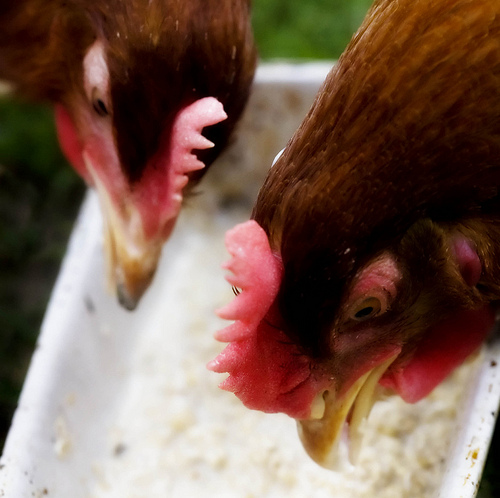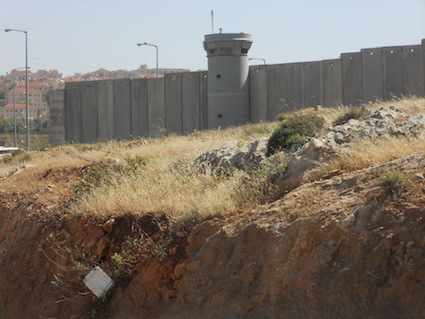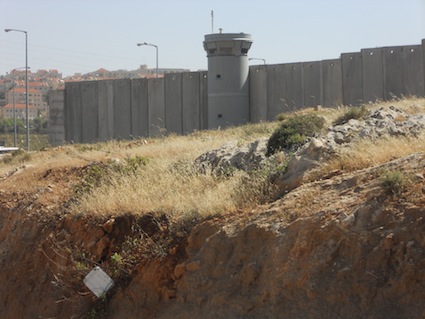 Not-so-great wall: Palestinian farmers say the real problem is the way water flows beneath this brutalist structure.Photos: Gary NabhanFor someone who lives within 12 miles of the infamous wall along the U.S.-Mexico border, it was an odd feeling to travel along the wall between Palestine and Israel last week just as Osama bin Laden’s death was announced to the world. Odd, because the parallels between the two desert regions are so remarkable. Palestinian farmers I spoke with were not interested in talking about the wall itself, nor the killing of bin Laden, nor the Hamas-Fatah unification. Instead, they wanted to talk water. Specifically, they were intent on having this American writer understand how their lives are affected by the ways water flows beneath the wall.
Not-so-great wall: Palestinian farmers say the real problem is the way water flows beneath this brutalist structure.Photos: Gary NabhanFor someone who lives within 12 miles of the infamous wall along the U.S.-Mexico border, it was an odd feeling to travel along the wall between Palestine and Israel last week just as Osama bin Laden’s death was announced to the world. Odd, because the parallels between the two desert regions are so remarkable. Palestinian farmers I spoke with were not interested in talking about the wall itself, nor the killing of bin Laden, nor the Hamas-Fatah unification. Instead, they wanted to talk water. Specifically, they were intent on having this American writer understand how their lives are affected by the ways water flows beneath the wall.
The environmental-justice issues surrounding the extravagant use and abuse of shared aquifers were what most concerned farmers from Ramallah, Nablus, and Jericho with whom I spoke. For decades, Israel and Palestine have struggled over how to share the same aquifers for domestic water use and for irrigated agriculture. Israel currently pumps roughly 82 percent of all the water extracted from the shared western aquifer, but it used to do 95 percent of the pumping only a half century ago, a fact that allows its defenders to claim that Israel has indeed allowed Palestinians more access to water. But the western aquifer is largely recharged under the West Bank, where Israel no longer agrees to let Palestinian farmers drill more wells. In defiance of this unilateral ban, Palestinians have clandestinely drilled more than 3,500 wildcat wells in the West Bank, which, once found, end up being contested in the courts. Prohibiting more wells in the West Bank, one Palestinian farmer told me last week, would be the equivalent of committing “environmental genocide.”
There are many reasons why Palestinians in the West Bank consider access to uncontaminated groundwater to be the most critical environmental-justice issue facing them. For starters, the average Israeli consumes at least two and a half times the water used by the average Palestinian in the West Bank. But averages do not tell the entire story. In Hebron in the southern reaches of the West Bank, many Palestinian and Bedouin families must get by on as little as four gallons of water per day, far less than the 26 gallons recommended by the United Nations as the minimum daily water requirement to maintain health. By contrast, the average Israeli per capita consumption is somewhere between 79 and 106 gallons per day. While more affluent urban Palestinians have inched their average consumption up from 18 to 76 gallons per day over the last couple decades, they still pay more than three times as much for water as Israeli settlers occupying the West Bank.
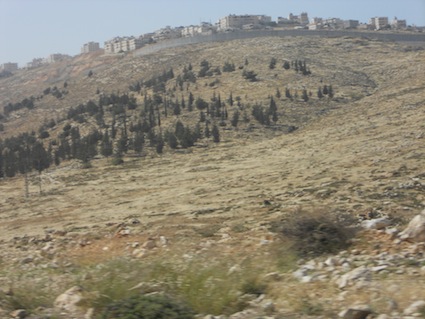 View of of Israeli settlements in the West Bank from the Palestinian side of the wall: In an arid region, water politics are paramount.But the most haunting water issue facing both Palestinians and Israelis may involve quality, not quantity — that is, access to water that has not been contaminated by endocrine-disrupting chemicals and antibiotic-resistant microbes. Despite recent claims by Israel’s Environmental Protection Minister Gilad Erdan that his nation is a world leader in saving water and recycling sewage, Israeli’s own environmentalists have dispatched repeated warnings of current and impending “gastrointestinal and reproductive health nightmares” because of the way Israel manages its nearly 66 million cubic yards of sewage. It places sewage — including all that it can obtain from Palestine — in reservoirs and uses 70 percent of it to irrigate its food crops. This sewage has irreparably contaminated the western aquifer, leading to high volumes of emergency room treatments in both countries for gastrointestinal tract disorders resulting from drug-resistant microbes. Worse yet, Israeli scientists Dan Zaslavsky and Alon Tal contend that the endocrine disrupters resulting from pesticide contamination of the aquifer may be a key factor contributing to the 40 percent reduction in human sperm counts in the region registered between 1994 and 2004. If these problems are not resolved by having the two countries work together to change the way they are managing sewage and farming, both Palestinian and Israeli families stand to suffer from a tragedy of biblical proportions, wall or no wall.
View of of Israeli settlements in the West Bank from the Palestinian side of the wall: In an arid region, water politics are paramount.But the most haunting water issue facing both Palestinians and Israelis may involve quality, not quantity — that is, access to water that has not been contaminated by endocrine-disrupting chemicals and antibiotic-resistant microbes. Despite recent claims by Israel’s Environmental Protection Minister Gilad Erdan that his nation is a world leader in saving water and recycling sewage, Israeli’s own environmentalists have dispatched repeated warnings of current and impending “gastrointestinal and reproductive health nightmares” because of the way Israel manages its nearly 66 million cubic yards of sewage. It places sewage — including all that it can obtain from Palestine — in reservoirs and uses 70 percent of it to irrigate its food crops. This sewage has irreparably contaminated the western aquifer, leading to high volumes of emergency room treatments in both countries for gastrointestinal tract disorders resulting from drug-resistant microbes. Worse yet, Israeli scientists Dan Zaslavsky and Alon Tal contend that the endocrine disrupters resulting from pesticide contamination of the aquifer may be a key factor contributing to the 40 percent reduction in human sperm counts in the region registered between 1994 and 2004. If these problems are not resolved by having the two countries work together to change the way they are managing sewage and farming, both Palestinian and Israeli families stand to suffer from a tragedy of biblical proportions, wall or no wall.
Currently, Palestine derives about a third of its gross national product from agriculture, while farm crops contribute less than 3 percent of Israel’s gross national product. The World Bank recently chastised Israel for not allowing Palestine to develop safer supplies of groundwater from deeper, larger, uncontaminated aquifers that Israel itself is already tapping. If Israel did so and let Palestinian farmers pass a portion of its harvests across the Red Line without the current harassment and bureaucratic interference that Palestinian farmers routinely face today, both countries might end up being more food secure.
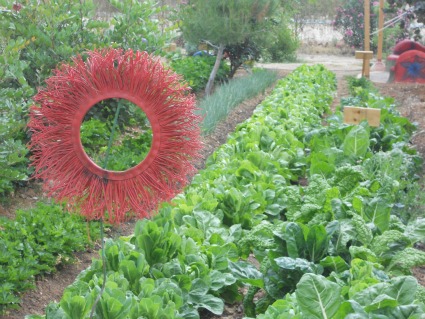 At a Friends of the Earth training center near Jericho, Palestinians grow crops in biologically treated sewage — an important skill, given that many of their other water sources have dried up.It was their preoccupation with having their human rights to food and water met that I heard most clearly from Palestinians on the “other side” of the wall. It reminded me of recent reports from Mexican border towns just south of Arizona and California that 44 percent of school students are living with the risk of hunger, and 82 percent of the households can be considered to be food insecure. Clearly, if Americans wish to be of service in helping Palestinians and Israelis resolve their conflicts, perhaps we should better model the behaviors we wish to see along any border by ensuring that Mexican and Native American children at our own back door have sufficient quantities of nourishing food and clean water. And if you believe that the water and food injustice along our border is any less severe than that being suffered along the wall that cuts the Holy Lands in two, come and see us down in southern Arizona, which barely ranks above Mississippi in its dismal levels of poverty and childhood food insecurity. If that’s not shocking enough for you, we’ll direct you on a tour to barrios just south of the wall where hunger and poverty are ramped up to a ferocity I’m certain you won’t be able to forget …
At a Friends of the Earth training center near Jericho, Palestinians grow crops in biologically treated sewage — an important skill, given that many of their other water sources have dried up.It was their preoccupation with having their human rights to food and water met that I heard most clearly from Palestinians on the “other side” of the wall. It reminded me of recent reports from Mexican border towns just south of Arizona and California that 44 percent of school students are living with the risk of hunger, and 82 percent of the households can be considered to be food insecure. Clearly, if Americans wish to be of service in helping Palestinians and Israelis resolve their conflicts, perhaps we should better model the behaviors we wish to see along any border by ensuring that Mexican and Native American children at our own back door have sufficient quantities of nourishing food and clean water. And if you believe that the water and food injustice along our border is any less severe than that being suffered along the wall that cuts the Holy Lands in two, come and see us down in southern Arizona, which barely ranks above Mississippi in its dismal levels of poverty and childhood food insecurity. If that’s not shocking enough for you, we’ll direct you on a tour to barrios just south of the wall where hunger and poverty are ramped up to a ferocity I’m certain you won’t be able to forget …
